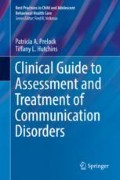Abstract
In this chapter, primary care providers learn about what learning disabilities or specific learning disorders are, as described in the DSM-5. Processes for diagnosis and assessment are reviewed. The concept of a nonverbal disability is also discussed. Prevalence, clinical expression, and etiology are highlighted. Implications for treatment are also provided.
Access this chapter
Tax calculation will be finalised at checkout
Purchases are for personal use only
References
Aaron, P. G. (1995). Differential diagnosis of reading disabilities. School Psychology Review, 24(3), 345–360.
American Psychiatric Association. (1980). Diagnostic and statistical manual (3rd ed.). Washington, DC: APA Press.
American Psychiatric Association (2000). Diagnostic and statistical manual (4th ed., Text Rev.). Washington, DC: APA Press.
American Psychiatric Association (2013). Diagnostic and statistical manual (5th ed., Text Rev.). Washington, DC: APA Press.
Bandian, N. A. (1999). Reading disability defined as a discrepancy between listening and reading comprehension: A longitudinal study of stability, gender differences, and prevalence. Journal of Learning Disabilities, 32(2), 138–148.
Barnes, M. A., Fletcher, J., & Fuchs, L. (2007). Learning disabilities: From identification to intervention. New York: The Guilford Press.
Bradley, R., Danielson, L., & Hallahan, D. P. (2002). Identification of learning disabilities: Research to practice. Mahwah, NJ: Erlbaum.
Center for Disease Control (2011). National Health Interview Survey 2007‑2009 data. Available at http://www.cdc.gov/nchs/nhis.htm.
Coutinho, M. J., & Oswald, D. P. (2005). State variation in gender disproportionally in special education: Finding and recommendations. Remedial and Special Education, 26(1), 7–15.
Fletcher, J. M., Lyon, G. R., Fuchs, L. S., & Barnes, M. A. (2007). Classification, definition and identification of learning disabilities. In Learning disabilities: From identification to intervention (pp. 25–63). NewYork: The Guilford Press.
Harrison, P. L., & Flanagan, D. P. (2005). Contemporary intellectual assessment: Theories, tests, and issues. New York: Guilford Press.
Hattie, J. (2009). Visible learning: A synthesis of over 800 meta-analyses relating to achievement. London/New York: Routledge.
Individuals with Disabilities Education Improvement Act of 2004. Pub L No. 108–446, §§ 1400 et seq.
Manoach, D., Sandson, T., & Weintraub, S. (1995). The developmental social-emotional processing disorders is associated with right hemisphere abnormalities. Neuropsychiatry, Neurophysiology, Behavioral Neurology, 8, 99–105.
Moats, L. C., & Lyon, G. R. (1993). Learning disabilities in the United States. Advocacy, sciences, and the future of the field. Journal of Learning Disabilities, 26, 282–294.
Morbidity and Mortality Weekly Report. (2011). QuickStats: Percentage of children aged 5‑17 years ever receiving a diagnosis of learning disability,* by Race/Ethnicity† and Family Income Group§ — National Health Interview Survey,¶ United States, 2007‑2009. MMWR, 60(25), 853. http://www.cdc.gov/nchs/nhis.htm
National Center for Learning Disabilities (2014). The state of learning disabilities (3rd ed.). New York: Author.
National Reading Panel (2000). Teaching children to read: An evidence-based assessment of the scientific research literature on reading and its implications for reading instruction. Retrieved from http://1.usa.gov/sOnDsl
National Research Center on Learning Disabilities (NRCLD) (2010). The Learning Disabilities Resource Kit: Specific Learning Disabilities Determination Procedures and Responsiveness to Intervention, NRCLD (National Research Center on Learning Disabilities). (Available online at http://www.nrcld.org/resource_kit/)
Prelock, P. A. (2013). What is a learning disability? In F. R. Volkmar (Ed.), Encyclopedia for autism spectrum disorders (1st ed.). New York: Springer.
Rourke, B. P. (1989). Nonverbal learning disabilities: The syndrome and the model. NewYork: The Guilford Press.
Rourke, B. P., Ahmad, S., Collins, D., Hayman-Abello, B., Sayman-Abello, S., & Warriner, E. (2002). Child clinical/pediatric neuropsychology: Some recent advances. Annual Reviews of Psychology, 53, 309–339.
Rourke, B. P., & Tsatsanis, K. D. (1996). Syndrome of nonverbal learning disabilities: Psycholinguistic assets and deficits. Topics in Language Disorders, 16, 30–44.
Semrud-Clikeman, M., & Hynd, G. (1990). Right hemispheric dysfunction in nonverbal learning disabilities: Social, academic, and adaptive functioning in adults and children. Psychological Bulletin, 107, 196–209.
Sternberg, R. J., & Grigorenko, E. L. (1999). Our labeled children: What every parent and teacher needs to know about learning disabilities. Reading, MA: Perseus Publishing Group.
Sternberg, R. J., & Grigorenko, E. L. (2001, December). Learning disabilities, schooling, and society. Phi Delta Kappa, 83, 335–338.
Stockard, J. (2008). Reading achievement in a direct instruction school and a ‘Three Tier’ Curriculum School (NIFDI Technical Report 2008. 5).
Stockard, J. (2009). Promoting early literacy of preschool children: A study of the effectiveness of Funnix beginning reading (NIFDI Technical Report 2009, 1).
Stockard, J. (2010). Promoting early literacy of preschool children: A study of the effectiveness of Funnix beginning reading. Journal of Direct Instruction, 10, 29–48.
Sun, L., & Wallach, G. P. (2014). Language disorders are learning disabilities. Challenges on the divergent and diverse paths to language learning disability. Topics in Language Disorders, 34(1), 25–38.
U. S. Department of Education. (2001). Twenty-third annual report to congress on the implementation of the individuals with disabilities education act. Washington, DC: Author.
U.S. Department of Education, Office of Special Education Programs, Individuals with Disabilities Education Act (IDEA) database, retrieved September 25, 2015., from http://www2.ed.gov/programs/osepidea/618-data/state-level-data-files/index.html#bcc; and National Center for Education Statistics, Common Core of Data (CCD), “State Nonfiscal Survey of Public Elementary/Secondary Education,” 2013–14. See Digest of Education Statistics 2015, table 204.30 and table 204.50.
Volden, J. (2004). Nonverbal learning disability: A tutorial for speech-language pathologists. American Journal of Speech-Language Pathology, 13, 128–141.
Wallach, G. P. (2005). A conceptual framework in language learning disabilities: School-age language disorders. Topics in Language Disorders, 25(4), 292–301.
Author information
Authors and Affiliations
Rights and permissions
Copyright information
© 2018 Springer International Publishing AG, part of Springer Nature
About this chapter
Cite this chapter
Prelock, P.A., Hutchins, T.L. (2018). Children with Learning Disabilities or Specific Learning Disorders. In: Clinical Guide to Assessment and Treatment of Communication Disorders . Best Practices in Child and Adolescent Behavioral Health Care. Springer, Cham. https://doi.org/10.1007/978-3-319-93203-3_7
Download citation
DOI: https://doi.org/10.1007/978-3-319-93203-3_7
Published:
Publisher Name: Springer, Cham
Print ISBN: 978-3-319-93202-6
Online ISBN: 978-3-319-93203-3
eBook Packages: Behavioral Science and PsychologyBehavioral Science and Psychology (R0)

